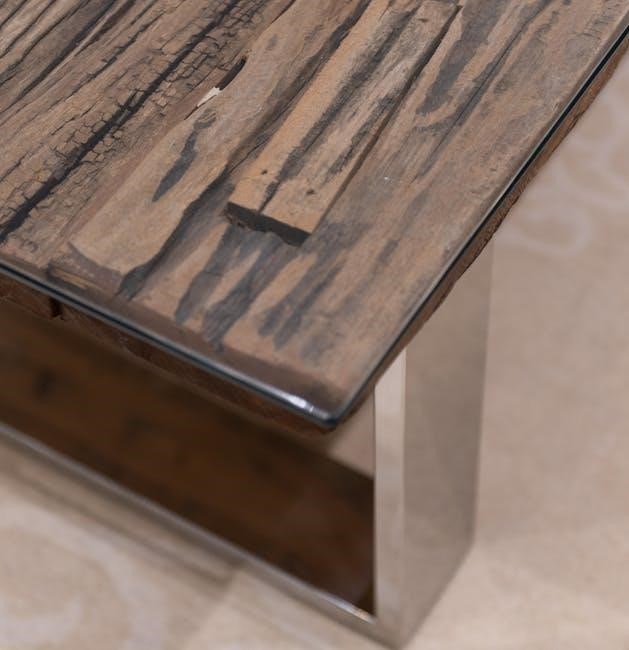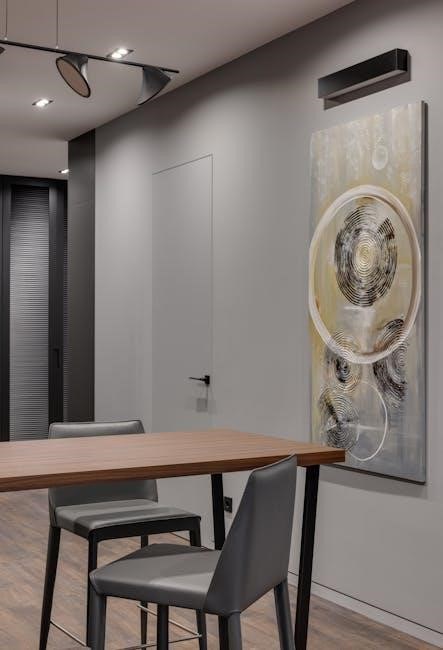The TRADA Timber Span Tables provide essential guidance for designing timber structures‚ offering section sizes and spans for floors‚ ceilings‚ and roofs in residential buildings efficiently.
Overview of TRADA Timber Span Tables
The TRADA Timber Span Tables are a comprehensive resource for designers and builders‚ providing essential data for sizing solid softwood timber members in residential constructions. The 4th edition includes section sizes and maximum spans for floors‚ ceilings‚ and roofs‚ excluding trussed rafter roofs. Designed for buildings up to three storeys‚ the tables cover softwood species and grade combinations meeting strength classes C16 and C24. They simplify the selection process‚ ensuring compliance with structural requirements. The tables are widely recognized as a key tool in timber construction‚ offering clear and accurate guidance for achieving safe and efficient designs in accordance with Eurocode 5 standards.
Key Features of the 4th Edition
The 4th Edition of the TRADA Timber Span Tables introduces enhanced design methods and updated section sizes‚ ensuring compliance with the latest Eurocode 5 standards. It includes revised span tables for solid softwood timber members‚ covering floors‚ ceilings‚ and roofs‚ with clear distinctions between domestic and other loading conditions. The edition incorporates new strength classes and timber sizes‚ reflecting modern material availability. A user-friendly layout improves readability‚ while metric and imperial measurements are provided for accessibility. The tables also address load-bearing capacities and deflection limits‚ offering practical guidance for designers and builders. This edition is a vital resource for ensuring safe‚ efficient‚ and compliant timber designs in residential and light commercial projects.

Understanding the Span Tables
Understanding the span tables is crucial for timber design‚ providing essential information on maximum spans‚ load capacities‚ and member sizes based on timber grades. They ensure structural safety and compliance.
How the Tables Are Organized
The TRADA Timber Span Tables are organized systematically to facilitate easy reference. Tables are categorized by timber strength classes and member sizes‚ with each table focusing on specific load-bearing capacities and maximum spans. They are further divided into sections for different applications‚ such as floors‚ ceilings‚ and roofs. The tables include columns detailing beam sizes‚ spans‚ and allowable loads‚ making it straightforward to determine suitable timber members for various designs. Additional information‚ such as service class and duration of load‚ is included to ensure accuracy in calculations. This clear structure enables users to quickly find relevant data‚ streamlining the design process while ensuring compliance with engineering standards.
Factors Affecting Span Calculations
Several factors influence the accuracy of span calculations using the TRADA Timber Span Tables. These include the strength class of the timber‚ which determines its load-bearing capacity‚ and the size of the timber section. Load duration‚ such as whether the load is permanent‚ variable‚ or transient‚ also plays a role. Service class‚ which refers to the environmental conditions (e.g.‚ humidity levels)‚ affects the material’s performance. Additionally‚ the type of load applied‚ whether it is uniformly distributed or concentrated‚ impacts the calculation. Proper consideration of these factors ensures the correct selection of timber members for safe and efficient structural design.
Interpreting Timber Grades and Sizes
Understanding timber grades and sizes is crucial for accurate design using the TRADA Timber Span Tables. Timber grades‚ such as strength classes (e.g.‚ C16‚ C24)‚ indicate the material’s structural performance and load-bearing capacity. Sizes refer to the cross-sectional dimensions of the timber‚ which must match the requirements of the design. The tables provide standardized data for various species and grades‚ enabling designers to select appropriate materials. Correct interpretation ensures compliance with structural integrity and safety standards. Proper matching of grades and sizes is essential to avoid under-specification‚ which could lead to structural failure. The tables simplify this process by categorizing timber based on its strength and dimensional properties.
Using the Span Tables for Design
The TRADA Timber Span Tables provide essential data for designing timber structures‚ enabling engineers to determine appropriate spans‚ sizes‚ and grades for safe and efficient construction.
Determining the Right Timber Size
Determining the right timber size is crucial for ensuring structural integrity and safety in construction projects. The TRADA Timber Span Tables provide detailed guidance‚ enabling designers to select appropriate timber sizes based on load-bearing requirements‚ span lengths‚ and intended use. Factors such as strength classes‚ section sizes‚ and timber species are considered to ensure compliance with building codes. By referencing the tables‚ professionals can identify the minimum dimensions required for beams‚ joists‚ and other structural elements. This ensures that the selected timber meets both functional and aesthetic demands while adhering to safety standards. Proper sizing also minimizes material waste and optimizes cost efficiency‚ making the tables an indispensable tool for accurate design decisions.
Calculating Maximum Spans for Floors and Ceilings
Calculating maximum spans for floors and ceilings is essential for ensuring structural stability and meeting design requirements. The TRADA Timber Span Tables provide pre-calculated data for various timber sizes‚ grades‚ and load conditions‚ enabling quick and accurate determinations. Factors such as timber species‚ strength classes‚ and imposed loads are considered to determine safe maximum spans. Designers can select appropriate section sizes by referencing tables tailored to specific applications‚ ensuring compliance with building codes. The tables also account for spacing between supports and deflection limits‚ making them a reliable resource for both residential and commercial projects. This ensures designs are both functional and structurally sound.
Considering Load-Bearing Capacities
Considering load-bearing capacities is critical when using the TRADA Timber Span Tables to ensure structural integrity. The tables provide detailed information on the maximum loads timber sections can safely support‚ factoring in strength classes and section sizes. Designers must account for both permanent and imposed loads‚ such as furniture‚ occupants‚ and construction materials. The tables also include safety margins to prevent overloading‚ ensuring compliance with structural design standards. By referencing these capacities‚ professionals can select appropriate timber sizes for floors and ceilings‚ balancing performance and safety. This ensures designs meet both functional and regulatory requirements‚ avoiding potential failures. Proper load assessment is vital for reliable outcomes.

Design Considerations
Design considerations involve evaluating structural requirements‚ safety standards‚ and practical limitations to ensure durability and compliance with building regulations. Proper workmanship and material selection are essential for long-term performance.
Building Height and Storey Limits

Building height and storey limits are critical when designing timber structures using TRADA Span Tables. These guidelines ensure compliance with safety standards and structural integrity. The tables specify maximum allowable heights and storeys based on timber grades‚ sizes‚ and load-bearing capacities. Understanding these constraints is essential for architects and engineers to design safe and durable buildings. Adhering to these limits ensures stability and security under various conditions‚ while also meeting local building codes and fire regulations. Proper consideration of height and storey limits is vital for achieving both functional and aesthetic goals in timber construction projects.
Exclusions and Limitations
The TRADA Timber Span Tables include specific exclusions and limitations to ensure safe and appropriate design practices. These tables exclude certain structural scenarios‚ such as trussed rafter roofs and highly loaded industrial floors‚ which require separate calculations. Additionally‚ limitations apply to deflection limits‚ load types‚ and moisture content‚ as these factors can significantly impact timber performance. Designers must adhere to these boundaries to avoid overloading or structural failure. It’s crucial to recognize these constraints to ensure designs remain within safe and practical parameters. Ignoring these limitations could lead to non-compliance with building codes or compromised structural integrity. Proper understanding is essential for reliable timber designs.

Importance of Proper Workmanship
Proper workmanship is critical to ensure the structural integrity and safety of timber constructions designed using the TRADA Timber Span Tables. Accurate jointing‚ alignment‚ and fastening are essential to achieve the intended strength and durability. Poor workmanship can lead to premature failure‚ even if the design complies with the span tables. Skilled labor and attention to detail are vital to prevent issues like warping or uneven loading. Adherence to manufacturer guidelines and building codes further ensures reliability. Proper workmanship not only enhances performance but also safeguards against potential hazards‚ making it a cornerstone of successful timber construction projects. Quality execution is as important as precise design.
Technical Specifications
The TRADA Timber Span Tables provide detailed technical specifications‚ including timber species‚ strength classes‚ section sizes‚ and imposed load calculations‚ ensuring precise engineering and design compliance.
Timber Species and Strength Classes
The TRADA Timber Span Tables detail various timber species and strength classes‚ providing essential data for designing structural elements. Common species include oak‚ pine‚ and spruce‚ while strength classes like C16 and C24 define load-bearing capacities. These classifications ensure materials meet specific performance requirements‚ guiding engineers and architects in selecting appropriate timber for different applications. The tables also account for variations in material properties‚ such as knot sizes and grain orientation‚ which impact structural integrity. By categorizing timber into standardized strength classes‚ the span tables simplify the design process‚ enabling accurate calculations for beams‚ joists‚ and other components in compliance with engineering standards.
Section Sizes and Spans for Dwellings
The TRADA Timber Span Tables provide detailed guidance on section sizes and maximum allowable spans for various dwelling applications. These tables are organized by timber strength classes‚ such as C16 and C24‚ and include dimensions for flooring‚ ceiling joists‚ and roof rafters. They also account for common domestic load requirements‚ ensuring safe and efficient designs. For example‚ a 200mm deep beam might span up to 4 meters for a floor load‚ while a 150mm deep joist could span 3 meters for a ceiling. These specifications help designers ensure structural integrity while optimizing material use‚ adhering to building codes and safety standards.
Imposed Load Calculations
Imposed load calculations are critical for determining the maximum allowable spans in timber structures. These loads‚ which include furniture‚ people‚ and movable items‚ vary based on the building’s use. The TRADA Timber Span Tables categorize imposed loads into domestic‚ residential‚ and other occupancy types‚ with typical values ranging from 0.25 to 1.0 kN/m². Designers must calculate these loads accurately to ensure structural safety and compliance with building codes. The tables provide formulas and guidance to account for uniformly distributed loads‚ concentrated loads‚ and load duration effects. Accurate imposed load calculations ensure timber elements are sized appropriately‚ balancing safety‚ efficiency‚ and cost-effectiveness in construction projects. Proper adherence to these guidelines minimizes risks and ensures compliance with regulatory standards.
Safety and Compliance
Ensuring timber structures meet safety standards and building codes is essential. Compliance with Eurocode 5 and UK Building Regulations guarantees reliability and safety in construction projects.
Adherence to Eurocode 5 Standards
The TRADA Timber Span Tables are developed in compliance with Eurocode 5‚ ensuring designs meet rigorous safety and performance requirements. Eurocode 5 provides principles for timber design‚ including load duration‚ moisture content‚ and material strength. The tables incorporate these standards to deliver reliable span and load-bearing capacities. Compliance ensures consistency with European design methodologies‚ making the tables a trusted resource for engineers and architects. Adherence to Eurocode 5 guarantees that timber structures are safe‚ durable‚ and meet regulatory expectations. This alignment is critical for achieving both structural integrity and compliance with building codes across the UK and Europe.
Relevant Building Regulations
The TRADA Timber Span Tables are designed to align with UK Building Regulations‚ particularly Part A (Structure) and Part L (Conservation of Fuel and Power). These regulations ensure that timber designs meet safety‚ structural integrity‚ and energy efficiency standards. The tables provide essential data for compliance‚ helping designers verify that timber elements meet required loads and spans. Compliance with Building Regulations is mandatory for all construction projects‚ and the span tables offer a reliable reference for achieving this. By adhering to these standards‚ designers can ensure their work is both legally compliant and structurally sound. Proper use of the tables aids in securing building control approval.

Tolerances in Construction
Tolerances in construction are critical to ensure the safe and accurate use of timber elements. The TRADA Timber Span Tables account for standard construction tolerances‚ ensuring designs remain reliable despite minor variations in material dimensions or installation. These tolerances are defined by industry standards and building codes‚ such as Eurocode 5‚ to accommodate potential deviations in timber sizes‚ moisture content‚ and manufacturing inconsistencies. Proper consideration of tolerances ensures that designs are robust and adaptable to real-world conditions. Ignoring these factors can lead to structural issues‚ making their inclusion in the span tables essential for achieving compliant and durable timber constructions.

Resources for Further Learning
The TRADA Timber Span Tables are supported by Wood Information Sheets‚ case studies‚ and technical guidance. These resources provide deeper insights and practical examples for timber design.
Wood Information Sheets
Wood Information Sheets are essential resources for understanding and applying the TRADA Timber Span Tables effectively. Published by TRADA‚ these sheets provide detailed guidance on various aspects of timber design‚ including material selection‚ design principles‚ and construction best practices. They complement the Span Tables by offering practical examples and explanations of key concepts‚ ensuring that designers and engineers can make accurate calculations and comply with building regulations. Topics covered include timber strength classes‚ manufacturing tolerances‚ and performance in different environmental conditions. These sheets are particularly useful for professionals seeking to enhance their understanding of timber engineering and ensure safe‚ durable‚ and efficient designs. They are available on the TRADA website for easy access and reference.
Case Studies and Technical Guidance
Case studies and technical guidance documents provide real-world applications of the TRADA Timber Span Tables‚ offering practical insights for engineers and architects. These resources highlight successful projects where the tables were used to design timber structures‚ showcasing innovative solutions and overcoming design challenges. Technical guidance includes step-by-step instructions‚ design aids‚ and best practices for interpreting and applying the span tables accurately. Additional tools‚ such as calculation checklists and software‚ are often provided to ensure compliance with Eurocode 5 and UK building regulations. These resources are invaluable for professionals seeking to enhance their skills in timber design and ensure safe‚ efficient‚ and durable structures.
Accessing the Latest Publications
To ensure accurate and up-to-date designs‚ accessing the latest publications of the TRADA Timber Span Tables is essential. The TRADA website offers downloadable PDF versions of the tables‚ along with supplementary guides and updates. Additionally‚ industry organizations and timber associations provide access to these documents through their online platforms. Professionals can also subscribe to newsletters or join membership programs to receive notifications about new editions or revisions. Always verify the publication date and edition to comply with current standards and regulations. Regularly checking for updates ensures designs remain safe‚ efficient‚ and aligned with the latest technical advancements in timber engineering.

Applications of the Span Tables
The TRADA Timber Span Tables are widely used for designing timber floors‚ ceilings‚ roofs‚ and load-bearing walls in residential and commercial construction projects.
Residential Construction
The TRADA Timber Span Tables are widely used in residential construction to determine the appropriate timber sizes for various applications‚ ensuring compliance with design standards. They provide essential data for designing floor joists‚ ceiling joists‚ and roof rafters‚ excluding trussed rafter roofs. The tables help architects and builders calculate maximum spans based on load-bearing capacities and timber grades. For domestic floor loads‚ the tables offer practical guidance on achieving safe and durable designs. By adhering to these span tables‚ professionals can ensure that residential structures meet Eurocode 5 standards and UK Building Regulations. Proper use of the tables also promotes efficient material use and cost savings.
Timber Flooring and Ceiling Designs
The TRADA Timber Span Tables provide essential guidance for designing timber flooring and ceiling systems‚ ensuring structural integrity and safety. These tables help engineers and architects select appropriate timber sizes and spans for various applications‚ considering load-bearing capacities and deflection limits. By referencing the tables‚ professionals can optimize material usage while meeting building regulations. The 4th edition includes updated data on domestic and commercial flooring‚ addressing factors like vibration and load distribution. This ensures designs are both durable and cost-effective‚ making timber a competitive choice for modern construction projects. Proper application of these tables minimizes risks and enhances overall performance in flooring and ceiling designs.
Roof Construction (Excluding Trussed Rafter Roofs)
The TRADA Timber Span Tables are invaluable for designing roof structures‚ offering detailed guidance for traditional roofing methods such as purlin and ridge board systems. These tables provide maximum spans for roof timbers based on strength classes and loading conditions‚ ensuring safe and efficient designs. Designers can select appropriate timber sizes and grades for rafters‚ purlins‚ and ridge boards‚ considering factors like roof pitch‚ coverings‚ and potential snow loads. The tables also align with Eurocode 5‚ ensuring compliance with structural safety requirements. This makes them an essential resource for constructing durable and compliant roof systems in residential and commercial projects.
The TRADA Timber Span Tables provide essential guidance for timber design‚ ensuring compliance and safety in construction projects. Always refer to the latest edition for accurate and reliable results.

Final Thoughts on Using TRADA Span Tables
The TRADA Timber Span Tables are an indispensable resource for engineers‚ architects‚ and builders‚ offering a comprehensive guide to designing timber structures safely and efficiently. By streamlining complex calculations‚ these tables ensure compliance with Eurocode 5 and UK building regulations‚ making them a cornerstone of modern timber construction. Their user-friendly format and detailed technical data empower professionals to make informed decisions‚ saving time and reducing errors. As the timber industry evolves‚ staying updated with the latest editions is crucial for incorporating innovative materials and methods. Utilizing these tables not only enhances design accuracy but also contributes to sustainable and durable building practices‚ ensuring projects meet both functional and aesthetic demands.

Importance of Staying Updated
Staying updated with the latest TRADA Timber Span Tables is crucial for ensuring compliance with current building codes and standards. Updates often include revisions to load calculations‚ timber grades‚ and design methodologies‚ reflecting advances in engineering and material science. New editions may incorporate changes in safety factors‚ environmental considerations‚ and construction practices. Professionals relying on outdated tables risk non-compliance with regulations‚ potentially leading to structural inefficiencies or safety hazards. Regularly checking for updates ensures that designs are both safe and efficient. Additionally‚ updated tables may include new timber species or section sizes‚ offering more design flexibility. Staying informed helps professionals maintain best practices and deliver reliable results.
